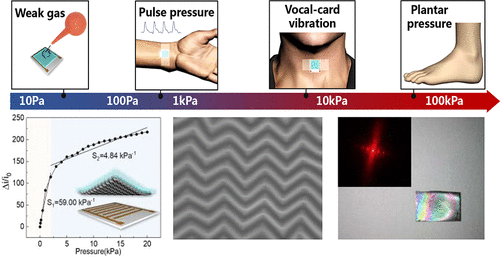当前位置:
X-MOL 学术
›
ACS Appl. Mater. Interfaces
›
论文详情
Our official English website, www.x-mol.net, welcomes your
feedback! (Note: you will need to create a separate account there.)
Controllable Graphene Wrinkle for a High-Performance Flexible Pressure Sensor
ACS Applied Materials & Interfaces ( IF 8.3 ) Pub Date : 2021-04-25 , DOI: 10.1021/acsami.0c22784 Xinyue Tang 1, 2 , Weidong Yang 3 , Shuran Yin 1 , Guojun Tai 1 , Min Su 1 , Jin Yang 4 , Haofei Shi 1 , Dapeng Wei 1, 2 , Jun Yang 1
ACS Applied Materials & Interfaces ( IF 8.3 ) Pub Date : 2021-04-25 , DOI: 10.1021/acsami.0c22784 Xinyue Tang 1, 2 , Weidong Yang 3 , Shuran Yin 1 , Guojun Tai 1 , Min Su 1 , Jin Yang 4 , Haofei Shi 1 , Dapeng Wei 1, 2 , Jun Yang 1
Affiliation

|
Flexible pressure sensors have aroused tremendous attention, owing to their broad applications in healthcare, robotics, and prosthetics. So far, it remains a critical challenge to develop low-cost and controllable microstructures for flexible pressure sensors. Herein, a high-sensitivity and low-cost flexible piezoresistive sensor was developed by combining a controllable graphene-nanowalls (GNWs) wrinkle and a polydimethylsiloxane (PDMS) elastomer. For the GNWs–PDMS bilayer, the vertically grown GNWs film can effectively improve the interface strength and form delamination-free conformal wrinkles. More importantly, a controllable microstructure can be easily tuned through the thermal wrinkling method. The wrinkled graphene-nanowalls (WG) piezoresistive sensor has a high sensitivity (S = 59.0 kPa–1 for the 0–2 kPa region and S = 4.8 kPa–1 for the 2–20 kPa region), a fast response speed (<6.9 ms), and a low limit of detection (LOD) of 2 mg (∼0.2 Pa). The finite element method was used to analyze the working mechanism of the sensor, which revealed that the periods of the wrinkles play a dominant role in the performances of the sensors. These prominent merits enable wrinkled graphene sensors to successfully detect various signals from a weak stimulus to large pressures, for example, the detection of weak gas and plantar pressure. Furthermore, object manipulation, tactile imaging, and braille recognition applications have been demonstrated, showing their great potential in prosthetics limbs and intelligent robotics.
中文翻译:

高性能柔性压力传感器的可控制石墨烯皱纹
柔性压力传感器由于其在医疗保健,机器人技术和假肢领域的广泛应用而引起了极大的关注。到目前为止,为柔性压力传感器开发低成本且可控制的微结构仍然是一个严峻的挑战。本文中,通过组合可控石墨烯-纳米壁(GNWs)皱纹和聚二甲基硅氧烷(PDMS)弹性体,开发了一种高灵敏度,低成本的柔性压阻传感器。对于GNWs-PDMS双层膜,垂直生长的GNWs膜可以有效地提高界面强度并形成无分层的保形皱纹。更重要的是,通过热起皱法可以容易地调节可控的微观结构。皱纹的石墨烯-纳米壁(WG)压阻传感器具有很高的灵敏度(S = 59.0 kPa –1对于0–2 kPa区域,对于2–20 kPa区域,S = 4.8 kPa –1),响应速度快(<6.9 ms),检测下限(LOD)为2 mg(〜0.2 Pa) 。有限元方法被用来分析传感器的工作机理,这表明皱纹的周期在传感器的性能中起主要作用。这些突出的优点使起皱的石墨烯传感器能够成功检测从弱刺激到大压力的各种信号,例如检测弱气体和足底压力。此外,还演示了对象操纵,触觉成像和盲文识别应用程序,显示了它们在假肢和智能机器人中的巨大潜力。
更新日期:2021-05-05
中文翻译:

高性能柔性压力传感器的可控制石墨烯皱纹
柔性压力传感器由于其在医疗保健,机器人技术和假肢领域的广泛应用而引起了极大的关注。到目前为止,为柔性压力传感器开发低成本且可控制的微结构仍然是一个严峻的挑战。本文中,通过组合可控石墨烯-纳米壁(GNWs)皱纹和聚二甲基硅氧烷(PDMS)弹性体,开发了一种高灵敏度,低成本的柔性压阻传感器。对于GNWs-PDMS双层膜,垂直生长的GNWs膜可以有效地提高界面强度并形成无分层的保形皱纹。更重要的是,通过热起皱法可以容易地调节可控的微观结构。皱纹的石墨烯-纳米壁(WG)压阻传感器具有很高的灵敏度(S = 59.0 kPa –1对于0–2 kPa区域,对于2–20 kPa区域,S = 4.8 kPa –1),响应速度快(<6.9 ms),检测下限(LOD)为2 mg(〜0.2 Pa) 。有限元方法被用来分析传感器的工作机理,这表明皱纹的周期在传感器的性能中起主要作用。这些突出的优点使起皱的石墨烯传感器能够成功检测从弱刺激到大压力的各种信号,例如检测弱气体和足底压力。此外,还演示了对象操纵,触觉成像和盲文识别应用程序,显示了它们在假肢和智能机器人中的巨大潜力。













































 京公网安备 11010802027423号
京公网安备 11010802027423号